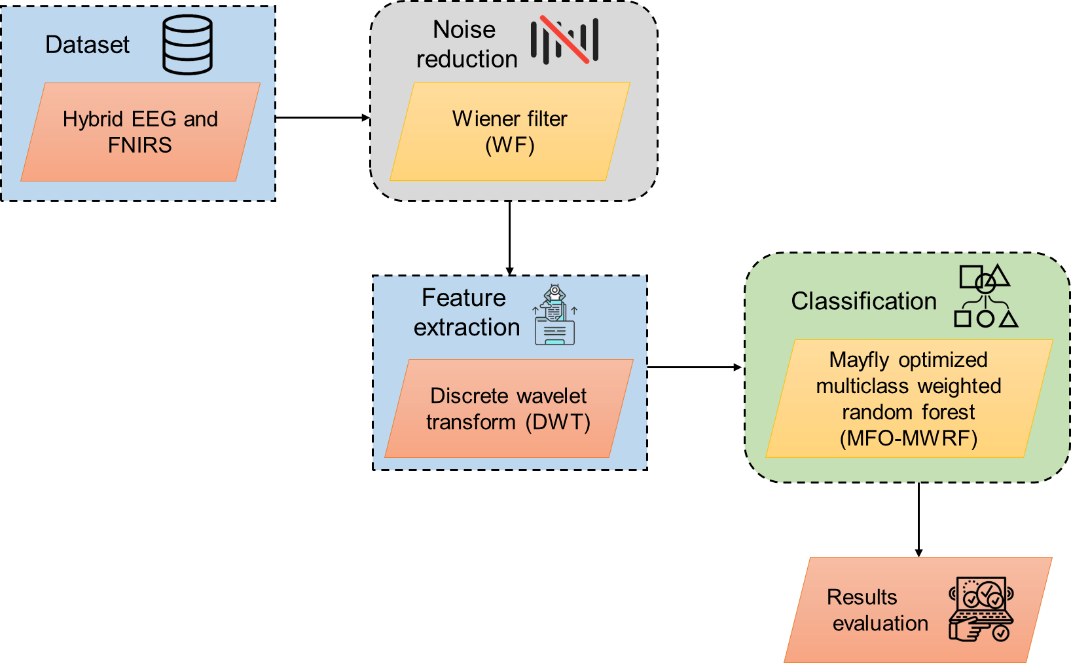Machine Learning-Based Classification of Hybrid BCI Signals using Mayfly-Optimized Multiclass Weighted Random Forest
Main Article Content
Abstract
The Brain-Computer Interface (BCI) technologies have excellent clinical and non-clinical uses. Among the most popular imaging methods adopted in BCI technologies is electroencephalography (EEG). But EEG signals are typically quite complicated, so analyzing them necessitates a significant amount of effort. With the help of machine learning (ML), this research investigates the feasibility of a BCI platform based on the motor imagery (MI) concept. The steps of pre-processing, feature extraction and classification are the underpinning of any conventional ML model. To train such a model, however, a large amount of data is needed. To address this gap, this work introduces a new mayfly-optimized multiclass weighted random forest (MFO-MWRF) technique that uses retrieved features as input to mitigate the need for this supplementary data. In this study, we gather a dataset of hybrid EEG and fNIRS motor imagery that can be pre-processed using a Wiener filter (WF) to filter out noisier signals without affecting the high-quality images. The characteristics are extracted using the discrete wavelet transform (DWT). The research results indicate that the proposed approach achieves the best performance compared to existing approaches for classifying motor movement images.
Article Details
References
S. Sadeghi, and A. Maleki, “A comprehensive benchmark dataset for SSVEP-based hybrid BCI,” Expert Systems with Applications, vol. 200, pp.117180, 2022.
R. Shelishiyah, M.B. Dharan, T.K. Kumar, R. Musaraf, and T.D. Beeta, “Signal Processing for Hybrid BCI Signals,” In Journal of Physics: Conference Series, Vol. 2318, No. 1, pp. 012-007, Aug 2022, IOP Publishing.
Z. Feng, Q. He, J. Zhang, L. Wang, X. Zhu, and M. Qiu, “A hybrid BCI system based on motor imagery and transient visual evoked potential,” Multimedia Tools and Applications, vol. 79, pp.10327-10340, 2020.
J. Choi, K.T. Kim, J.H. Jeong, L. Kim, S.J. Lee, and H. Kim, “Developing a motor imagery-based real-time asynchronous hybrid BCI controller for a lower-limb exoskeleton,” Sensors, vol.20, no.24, pp.7309, 2020.
L. Wang, X. Liu, Z. Liang, Z. Yang, Z. and X. Hu, “Analysis and classification of hybrid BCI based on motor imagery and speech imagery,” Measurement, vol. 147, pp.106842, 2019.
X. Cai, and J. Pan, “Toward a brain-computer interface-and internet of things-based smart ward collaborative system using hybrid signals,” Journal of Healthcare Engineering, 2022.
Yadav , A. K. ., Bhaskar Ch. , V. ., M., N. ., Raja, J. E. ., S. Pund, S. ., & Kumari , A. . (2023). A Secure Multi-Path Communication through Dynamic Path Identifiers to Prevent Denial-of-Service Flooding Attacks. International Journal of Intelligent Systems and Applications in Engineering, 11(3s), 22–28. Retrieved from https://ijisae.org/index.php/IJISAE/article/view/2527
L.W. Ko, O. Komarov, and S. C. Lin, “Enhancing the hybrid BCI performance with the common frequency pattern in dual-channel EEG,” IEEE Transactions on Neural Systems and Rehabilitation Engineering, vol. 27, no. 7, pp.1360-1369, 2019.
Y. Wei, J. Li, H. Ji, L. Jin, L. Liu, Z. Bai, and C. Ye, “A Semi-Supervised Progressive Learning Algorithm for Brain–Computer Interface,” IEEE Transactions on Neural Systems and Rehabilitation Engineering, vol. 30, pp.2067-2076, 2022.
Z. Sun, Z. Huang, F. Duan, and Y. Liu, “A novel multimodal approach for hybrid brain–computer interface,” IEEE Access, vol. 8, pp.89909-89918, 2020.
D. Yang, T.H. Nguyen, and W.Y. Chung, “A bipolar-channel hybrid brain-computer interface system for home automation control utilizing steady-state visually evoked potential and eye-blink signals,” Sensors,vol. 20, no.19, pp.5474, 2020.
C. Chen, P. Zhou, A. N. Belkacem, L. Lu, R. Xu, X. Wang, W. Tan, Z. Qiao, P. Li, Q. Gao, and D. Shin, “Quadcopter robot control based on a hybrid brain–computer interface system,” Sensors and Materials, vol. 32, no. 3, pp.991-1004, 2020.
M.A. Hasan, M.U. Khan, and D. Mishra, “A computationally efficient method for hybrid EEG-fNIRS BCI based on the Pearson correlation,” BioMed Research International, pp.1-13, 2020.
Rajesh Kumar Chaudhary, M. K. C. (2021). The Role of School Management Towards Staff Motivation for Effective Performance in Nepal: During the Covid-19. International Journal of New Practices in Management and Engineering, 10(01), 01–11. https://doi.org/10.17762/ijnpme.v10i01.93
Y. Zhang, S.Q. Xie, H. Wang, and Z. Zhang, “Data analytics in steady-state visual evoked potential-based brain–computer interface: A review,” IEEE Sensors Journal, vol. 21, no. 2, pp.1124-1138, 2020.
A. Chowdhury, A. Dutta, and G. Prasad, “Corticomuscular co-activation-based hybrid brain-computer interface for motor recovery monitoring,” IEEE Access, vol. 8, pp.174542-174557, 2020.
V. Chamola, A. Vineet, A. Nayyar, and E. Hossain, “Brain-computer interface-based humanoid control: A review,” Sensors, vol. 20, no. 13, pp.3620, 2020.
Christopher Davies, Matthew Martinez, Catalina Fernández, Ana Flores, Anders Pedersen. Machine Learning Approaches for Predicting Student Performance. Kuwait Journal of Machine Learning, 2(1). Retrieved from http://kuwaitjournals.com/index.php/kjml/article/view/174
M. Saadati, J. Nelson, and H. Ayaz, “Multimodal fNIRS-EEG classification using deep learning algorithms for brain-computer interfaces purposes,” In Advances in Neuroergonomics and Cognitive Engineering: Proceedings of the AHFE 2019 International Conference on Neuroergonomics and Cognitive Engineering, and the AHFE International Conference on Industrial Cognitive Ergonomics and Engineering Psychology, July 24-28, 2019, Washington DC, USA vol. 10, pp. 209-220, 2019. Springer International Publishing.
W. Luo, W. Yin, Q. Liu, and Y. Qu, “A Hybrid Brain-Computer Interface Using Motor Imagery and SSVEP Based on Convolutional Neural Network,” arXiv preprint arXiv, pp. 2212.05289, 2022.
A. Jayanthi, and E.C. Djamal, “Hybrid CNN-RNN in Motor Imagery Identification of Brain-Computer Interface,” In 2021 8th International Conference on Advanced Informatics: Concepts, Theory, and Applications (ICAICTA), pp. 1-6, September 2021, IEEE.

